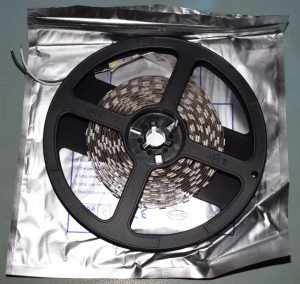Testing LED strip
Many people do not realise how much heat is generated by modern high brightness LEDs. An old-fashioned 100W incandescent light bulb produces around 5% visible light, 83% infrared radiation and 12% heat. An equivalently bright LED bulb might produce 30% visible light and 70% heat. Although the total power consumption is much less (around 17W for the LED), the amount of heat which must be dissipated at the source is almost the same (12% of 100W is 12W, 70% of 17W is 11.9W), and LEDs are easily damaged by excessive heat.
A recent purchase of 5m of inexpensive (£2.59) white LED strip prompted an investigation of its performance, particularly the thermal properties. Excessive heat often causes rapid failure of LED strips, so this seemed likely to be a useful exercise.
This investigation began with a 0.5m length of warm white 5050 SMD strip with 60 LED chips per metre. 5050 LED chips have three diodes per chip, as can be seen here:

The strip was supplied as a 5m reel in a sealed bag. This is made up of 10 0.5m sections joined by solder blobs into a continuous length. Powering a 5m strip from one end can result in a very large voltage drop between one end and the other – typically several volts. This will result in visibly dimmer LEDs at the far end of the strip.

One of these 0.5m sections was tested loose and a second section was mounted in a 0.5m aluminium channel designed for the purpose:
![]()
The channel was supplied with a translucent cover strip:
![]()
With a 12V supply, this length of strip consumed 0.9A of current; around 11W of power. The temperature was allowed to reach equilibrium and measured with a thermocouple. Ambient temperature was 20 °C.
| Description | Temperature |
| Loose strip | 57.0 °C |
| Uncovered aluminium channel | 48.4 °C |
| Covered aluminium channel | 59.6 °C |
These temperatures are fairly high – the aluminium part of the covered strip was too hot to hold. Consequently the effect of reducing the voltage supplied to the strip was observed. The amount of light generated at each voltage was also measured using a meter:
| Voltage | Current | Power | Temperature | Illuminance at 0.3m |
| 12.0 V | 0.93 A | 11.2 W | 57 °C | 920 lux |
| 11.5 V | 0.78 A | 9.0 W | 52 °C | 810 lux |
| 11.0 V | 0.64 A | 7.0 W | 45 °C | 740 lux |
| 10.5 V | 0.50 A | 5.2 W | 40 °C | 630 lux |
| 10.0 V | 0.37 A | 3.7 W | 34 °C | 480 lux |
As can be seen, dropping the voltage can offer considerably lower temperatures with a still very respectable light level. If maximum brightness is not an issue, such strips are likely to offer much longer life if run at less than the rated voltage – particularly since many nominal 12 V supplies provide a somewhat higher voltage such as 12.4 V, with a corresponding increase in strip temperature.
 Previous Post
Previous Post Next Post
Next Post